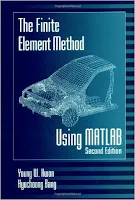The Finite Element Method Using MATLAB
Young W. Kwon, Hyochoong Bang ... 624 pages - Publisher: CRC Press; 2nd edition (July 28, 2000) ...
Language: English - ISBN-10: 0849300967 - ISBN-13: 978-0849300967 ...
Expanded to include a broader range of problems than the bestselling first edition, Finite Element Method Using MATLAB: Second Edition presents finite element approximation concepts, formulation, and programming in a format that effectively streamlines the learning process. It is written from a general engineering and mathematical perspective rather than that of a solid/structural mechanics basis.
What's new in the Second Edition?: Each chapter in the Second Edition now includes an overview that outlines the contents and purpose of each chapter. The authors have also added a new chapter of special topics in applications, including cracks, semi-infinite and infinite domains, buckling, and thermal stress. They discuss three different linearization techniques to solve nonlinear differential equations. Also included are new sections on shell formulations and MATLAB programs. These enhancements increase the book's already significant value both as a self-study text and a reference for practicing engineers and scientists.
Language: English - ISBN-10: 0849300967 - ISBN-13: 978-0849300967 ...
Expanded to include a broader range of problems than the bestselling first edition, Finite Element Method Using MATLAB: Second Edition presents finite element approximation concepts, formulation, and programming in a format that effectively streamlines the learning process. It is written from a general engineering and mathematical perspective rather than that of a solid/structural mechanics basis.
What's new in the Second Edition?: Each chapter in the Second Edition now includes an overview that outlines the contents and purpose of each chapter. The authors have also added a new chapter of special topics in applications, including cracks, semi-infinite and infinite domains, buckling, and thermal stress. They discuss three different linearization techniques to solve nonlinear differential equations. Also included are new sections on shell formulations and MATLAB programs. These enhancements increase the book's already significant value both as a self-study text and a reference for practicing engineers and scientists.





